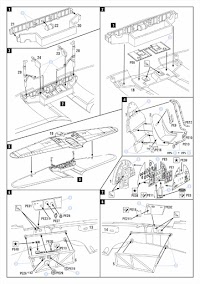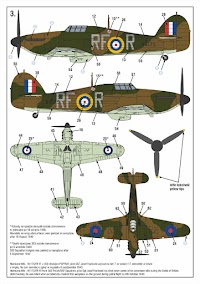Polish Hurricane

Following the P.11c model released not so long ago, Arma Hobby from Poland reached for a more mainstream subject and announced a 1:72 scale Hawker Hurricane Mk.I. This may not piqued my interest like TS-11, nevertheless I decided to take a closer look at the new set as soon as it hit the stores.
Almost like 109
Judging by the reactions which the announcement of this model prompted- not everyone was delighted with the direction taken by Arma. After all, Hurricane is almost as niche subject as the Bf 109. The proposed version however is not represented in 1:72 by the modern quality set. Less informed modellers pointed to somewhat fresh kit from Airfix- but the Brits released an early version with wings partially covered with fabric. Rarer, and frankly speaking less interesting.
"Metal-wing” Hurri is of course also available in mentioned scale, but those are sets developed years ago (Hasegawa), or short-run kits (AZ Model), with an adequate production quality. So this is not such a bad choice overall, and considering the economic aspect- quite a sensible move.
All that remains is to sympathize with Hobby 2000 company, which at the beginning of this year made its debut as a producer, offering repackaged Hasegawa kits with Polish squadrons decals. Soon afterwards Arma Hobby revealed its highly advanced project. Ops.
First look
The kit in question (catalogue number 70019) is packed typical for this manufacturer- side-opening box in a standard colour scheme for this products line, with cover art by Marcin Górecki. At the back- four side profiles showing the versions that can be made with the attached markings. But we will come back to that later.
Inside- one light grey plastic frame (cut into two pieces just to fit into a standard Arma Hobby box- and it still fits barely), transparencies, a small photo-etched set, masks, sizeable decals sheet and instructions.
There is a separate string bag provided for the photo-etched elements and masks, but the small transparent frame slides loosely in the collective bag with everything else. Admittedly, in my case that did not cause any scratches on the canopies, but you could not be so lucky.
Plastic
The fuselage has been conventionally split into two halves- there is no separate segment that would indicate the future sea version. Instead we have subtly represented fabric sections and quite delicate panel lines.
Looking closer you will also notice an old friend from previous Arma Hobby models- remnants of mould milling process. Those are most visible on the lowered part of the fuselage behind the pilot's seat, but the keen eyes will also find them on other elements. In this case however, removing them should not cause any major problems.
As you can see, kit designer opted for a completely separate vertical stabilizer, which together with the rudder (which has delicately reproduced fabric sagging) can be found on the cut off part of the main frame.
Horizontal stabiliser has been engineered as one element, with separate control surfaces. By the way, you can also spot the rather poorly looking exhausts (with solid ends of course) on this photo.
Similarly to the Airfix model, the wing is divided into two main sections. The upper surfaces, connected by the ceiling of the main landing gear bay, which serves also as the base for the cabin floor.
And the lower portion with an adequate cut-out for the above-mentioned bay. In both cases we get elements covered with raised and recessed details, and the control surfaces have been indicated by the thicker lines (although little inconsistently). It is worth mentioning, especially in the context of comparisons with the Airfix kit, that in this case wings trailing edges are really thin.
Mentioned earlier main landing gear bay consists of a ceiling, which in this version should be covered with a more detailed PE element.
Plus separately designed walls.
Assembling of the entire structure will probably be easier thanks to the internal surface of the wings.
Main wheels also make a good first impression, quite nice for a plastic parts.
You can find "DUNLOP" inscription on both sides of the tire (ooo.... brave).
Wheel bay covers also look quite bearable, although the plastic parts will never be thin enough.
It all looks quite well, so it is really shame that we encounter here and there some sink marks, notorious for this manufacturer. For example on such a small detail like a gas tank glued into a landing gear bay.
On the second to last picture you can also spot propellers bases, onto which individual blades (two version provided) should be glued. Contrary to the pre-release concerns, the correct positioning of those elements was ensured through the use of fixing pins.
The propeller can be covered with one of three spinners. We get the possibility of making both de Havilland and Rotol propellers, the latter also with a cone adapted from Spitfire.
Right next to the blades on the frame you will find a radiator, which on one hand makes you happy.
On the other hand, is slightly disappointing due to the sink mark. In the "Expert" edition this is not a problem however, because that part is saved by PE elements.
As I mentioned earlier- Sea Hurricane is not to be expected, but for some consolation we get the possibility of making a tropical version. Small thing, but nice.
The cockpit interior is quite extensively detailed for this scale. We can find a little bit inside of the fuselage halves.
Injection-moulded truss sections do not give a bad impression, considering the material.
The floor and rear wall of the cockpit with armour also looks nice.
Pilot seat can be found on a "small frame" and, as for injection moulding, it is not even that thick.
Instruments panel unfortunately belong to parts deformed by sinking of plastic. Again- in the "Expert Set" this is not a problem, but that won’t be that simple in the announced "Junior" edition, which will not contain the PE parts.
Photo-etched elements will also be useful in the case of pedals. No, these are actually well cast, but plastic elements will always look too clumsy in this scale.
By the way, I would like to draw your attention to the separate elevator visible on the last photo, which I mentioned somewhere at the beginning of this discussion.
Transparencies
Small clear frame contains a windscreen with separate movable canopy prepared in two versions- to be used with the cockpit closed and open.
Clarity is on a pretty good level, not perfect, but certainly acceptable.
There is another problem however- the canopies are way too thick. Really- straight from the box build with open cabin is out of the question. At least in my opinion.
In addition to the canopy, transparent frame contains also some smaller details such as spotlights or gunsight.
Extras
"Expert" edition is not only about plastic of course. A photo etched plate, although small in size, actually contains the most necessary elements such as seatbelts, instrument panel or radiator grids. Plus bonus parts in the form of oil deflector ring and exhausts shielding, which were not present on the machines with markings offered in this kit.
We also get masks for painting the transparencies (including wing lights) and the wheels. What we don't get is a typical clear film with printed flying instruments dials for use with PE panel. Instead we are instructed to use provided decal.
Decals
Included sheet of rather substantial size contains markings for four machines, with three versions of roundels and fin-flashes.
This time it was produced by Techmod, but in no way does this mean a drop in quality. The print is precise and sharp, and I did not find any colour shifts or other errors of this nature.
As a bonus, in addition to all the markings that will not be used, we also get a second set of stencils and instrument panel gauges.
Just if anyone wanted to use them in some other manufacturer’s kit or bought Arma's just-plastic set. Which you could buy only before the kit release, but don’t get mi started on this.
Manual
Standard for this manufacturer, clear and aesthetic. One would like to write "as usual", but this is actually not entirely true.
This time it is a smooth guide to the construction of the model with use of all elements available in the box (in the previous sets the assembly of the photo-etched parts was presented in a separate module). A change for good, if you ask me.
Second part of the manual contains a presentation of available painting options. Each of four version has been illustrated with colour profiles, indicating also the location of appropriate decals.
Paints suggested by the manufacturer are exclusively of Hataka brand, which although not surprising, is just not cool. As a consolation we also get more or less accurate FS numbers. However in this case, with standard British colours, it will not be a real problem.
Painting options
Arma Hobby offered us four variants in this set, with a significant prevalence of Polish pilots' planes. Two machines on which Antoni Głowacki flew in No. 501 Squadron RAF (P3059 SD-N and V7234 SD-A), one from the famous 303 Squadron (R4175 RF-R of J. Frantisek) plus, for a change- tropical Hurricane from No. 3 Squadron SAAF (284 J).
Pretty cool, if you like Polish themed machines, but to be honest- rather boring. Two Głowacki's machines aside- even the tropical version is in the standard european camouflage. Maybe Arma is planning to release an edition with some more diverse painting options, I don't know. I just think that the first edition could have been a bit more attractive. Which doesn't mean it's bad, not at all.
Summary
Contrary to complains written above, I consider the new Hurricane from Arma Hobby to be a pretty nice kit. Of course not without some drawbacks- but those pale in comparison with the well thought-out design and pretty good details. Plus, in this edition at least, some bugs are eliminated by the attached PE parts.
On the other hand, I wouldn't be upset if the next new model released by this manufacturer (what will it be? Arma Hobby hasn't revealed it yet) didn't have sink marks and the canopy was a bit thinner. Well, we will see.










































